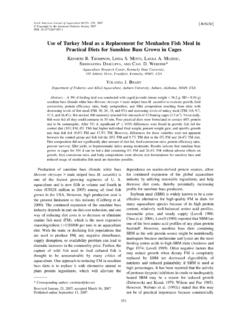Transcription of GAINING MUSCULAR SIZE & STRENGTH FOR A …
1 GAINING . MUSCULAR size & STRENGTH . FOR. a championship physique . Chuck Sipes Super-Seminar How He Won The 1968 IFBB Mr. World Title . By Dennis B. Weis The Yukon Hercules . Distributed by 2003 Dennis B. Weis In Memory Of Chuck H. Sipes (August 22, 1932-February 24, 1993). 1959 IFBB Mr. America 1961 IFBB Mr. Universe 1966 4th place-IFBB Mr. Olympia 1968 IFBB Mr. World 2. A GREAT CHAMPION OF YESTERYEAR. REVEALS PRO-BODYBUILDING STRATEGIES. FOR WINNING CONTESTS. The mid-1960s was a very exciting time for many of us Baby Boomers (born during the Second World War) who were involved in the physical culture scene, for we were able to experience a Golden Era of the sport. The Golden Era was a magical time on the physical culture scene where non- and amateur-competing bodybuilders alike had to rely on reasonably logical and competent training and nutritional strategies (who can forget Rheo H. Blair, the super nutrition expert, and his wildly popular milk-and-egg-protein powder) for acquiring marked increased in MUSCULAR size and STRENGTH .
2 There was also emerging in this Golden Era a new breed of elite competing and winning bodybuilder, the IFBB Professional. Who can forget such legendary names as Dave Draper, Don Richard Howorth, Sergio Oliva, Harold Poole, Larry Scott, Arnold Schwarzenegger, and last but not least in the IFBB parade of champions, Chuck Sipes. 3. The late Chuck Sipes was a huge, thickly muscled man, not too tall but amazingly compact and massive. He had a ruggedness written over his physiognomy and a broad grin for everyone. He reflected a cheerful atmosphere and personal attitude wherever he went. However, when he began a workout, his concentration was so laser-focused that it was obvious to those around him that he did not want to be interrupted. It was this frame of mind that netted him contest-winning results at the elite IFBB professional level. Now, get ready to step back into the sixties and check into the mind of one of pro-bodybuilding s best, and begin to absorb the knowledge of the training and nutrition strategies it took to win an IFBB show.
3 The following seminar contains exact insights and expressions from the late Chuck Sipes, a man who was deeply embedded in the trenches of bodybuilding warfare. If you ever had the opportunity to hear Chuck speak, you may recall his speech pattern and recognize his training philosophy as it is represented in this eReport. Chuck receiving the trophy for winning the 1968 IFBB Mr. World title The following information is the pure truth from Sipes on the exact program he followed in preparation for the IFBB Mr. World title. At the conclusion of this program, Chuck attained a peak condition where, at 5 feet 9 inches, he weighed 220 pounds. His measurements were: arms, 19 inches; chest, 50. inches; waist, 32 inches; thighs 25 inches; calves, 18 inches. He was especially known for his massive and powerful forearms, which measured 18. inches pumped. Sipes was also enormously strong. He could bench press 570. pounds (at 220 pounds of MUSCULAR bodyweight), perform full squats with 600.
4 Pounds, and do barbell curls with 250 pounds. Here, then, is the Chuck Sipes bodybuilding seminar in which he explains his revolutionary training and nutritional philosophies that allowed him to obtain his best gains in size , shape, and muscularity and go on to win the 1968 IFBB Mr. World contest. He also won the subdivisions of most MUSCULAR , best arms, best chest, and best abs. 4. TO BECOME A WINNER OF A physique TITLE. TAKES MANY MONTHS OF PREPARATION . I planned my contest preparation for the 1968 IFBB Mr. World contest twelve months prior to entering. I feel that this is one of the most important phases toward contest training, in that one must plan his or her training, far enough in advance to get their training organized and to devote every waking minute of the day toward the task at hand. As far as my training went, I trained three times per day (Authors comment: This is the dynamic Triple-Split training principle that the top bodybuilders and weightlifting champions in the world have been using for the last few years to achieve the maximum in size and STRENGTH ), six days per week, towards winning the 1968 IFBB Mr.
5 World contest. Being employed with the California Youth Authority as the personal weight training instructor helped me to organize my training so that I was able to train three times per day. I would begin my daily training at around 6:00 at my home. My work for the California Youth Authority was the swing shift that began at 2:00 to 10:00 in the evening. It was here that I would get into the second and third workout sessions for the day. My second workout of the day began immediately upon arriving at work at 2:00 being that my job was to teach weight training to the CYA youths. It was here that I would get in my second workout of the day and then between 8:00 and 10:00 in the evening I was assigned to dorm duty in which I was to be there while the young men slept for the night. It was here that I. concentrated on my third and final workout session of the day. (Authors comment: Before Chuck outlines his explicitly calculated training program, it is important to note that he followed the PUSHIPULL training principle where he would train his pushing muscles, , pecs, delts, and triceps, on training days one, three, and five; and on days two, four, and 5.)
6 Six, he would train his pulling muscles-legs, back, biceps, and forearms. You will notice as he explain a particular exercise schedule that special attention was given to working from the largest muscle group to the smallest for the particular training sessions at hand. This is one of his secrets of developing SUPER-HUMAN STRENGTH .). TRAINING DAYS ONE, THREE, AND FIVE. MORNING SESSION 6:00 Chest: I have always enjoyed bench pressing, so I would begin this particular session by doing SUPINE or flat bench presses. I would always warm up with, say, 135. pounds, and then gradually I work light to heavy, say, for instance, I would do two sets of 8 reps, then two sets of 4 reps, then two sets of 2 reps, and finally two sets of one single rep, working toward my best single maximum poundage for this session. (Authors comment: This is the famous double set light to heavy training principle.). After I finished doing the two single repetitions, I would then do a SUPPORT.
7 MOVEMENT (making use of a power rack), which I feel is the only way one can gain tremendous STRENGTH . Here I would place the holding rods (Authors comment: This is the point where the barbell is actually positioned prior to beginning the actual exercise movement) in the power rack where the bar was positioned just below the actual arms-locked-out position in the supine or flat bench press position. I would position myself correctly on the bench and proceed to push the barbell off the holding rods to an arms-locked position. I. would begin by holding the barbell at this locked-arms position of support for approximately five seconds. As my training in this exercise over the weeks and months progressed, I would add more time supporting the barbell, but never more than twenty seconds per set. Then, of course, when this became easy I would add more poundage to the barbell, because the importance of this and any exercise is always to progress either by adding time upon the effort or adding poundage upon the effort.
8 At this particular time in my training I was working toward attempting a 600-pound supine bench press, which I wanted to do at the upcoming IFBB 1968 Mr. World contest. At the time I was training for this contest, many people believed that bodybuilders just trained with light weight and were pumpers. I wanted to prove that not all bodybuilders trained with light weights, and, in fact, any leading bodybuilder today, in order to develop to the maximum in size , has to handle heavy poundages. I firmly believe that this one exercise (bench supports in the power rack) done for 4 sets of 5 seconds to 20 seconds each helped me greatly in 6. developing my chest and arms to their maximum size . As far as my rest pauses between sets went, I would wait only long enough until my mind tells me that I'm ready to begin another set. I like to keep the blood flowing in the muscle while keeping up a good exercise rhythm and a good sweat during my training sessions.
9 (Authors comment: It is interesting to note that sweating burns up three calories per teaspoon of perspiration.). I really believe in sweating, and I usually wear a sweatshirt even in the warmer months of the year. After I did the supports on the bench press, I then would proceed to do some Dead Stop Bench Presses. On this particular exercise, I would again make use of the power rack and reposition the holding rods from the previous exercise to a point where the barbell would be positioned approximately four inches above the chest. I would decrease the poundage just enough to where I could do from four to six reps, so that on about the sixth rep I was putting out maximum effort. I firmly believe that this exercise builds explosive power in the bench press. It gives one the ability to explode from the dead space just about the chest. (Authors comment: One of the critical sticking points in the bench press). As far as being able to tell you what poundages I used on the bench press, it would be fairly hard for me to go back that far, because I didn't record them.
10 I. always trained to the maximum on the bench press three times per week. I. would always force myself to handle more and more poundage, and by doing this I was able to bring my bench press up to 570 pounds, weighing approximately 220 pounds. The dead stop bench presses were done for 4 sets of 6 reps. From this exercise I went to Straight Arm Pullovers with a barbell. I believe that this exercise is tremendous for chest development and of utmost importance for rib cage development. On this exercise I would normally do three sets of 15. repetitions, and my poundages on the pullovers would run around 125 pounds. I. don't believe that using heavy poundages on the pullover is the answer (toward chest and rib cage development), but the answer is to use lighter weights and keep the arms straight and stretch, stretch, stretch, and concentrate on deep breathing. From here I would then go to Dumbbell Flies on a flat bench, bending the elbows slight and again stretching, stretching, stretching.





